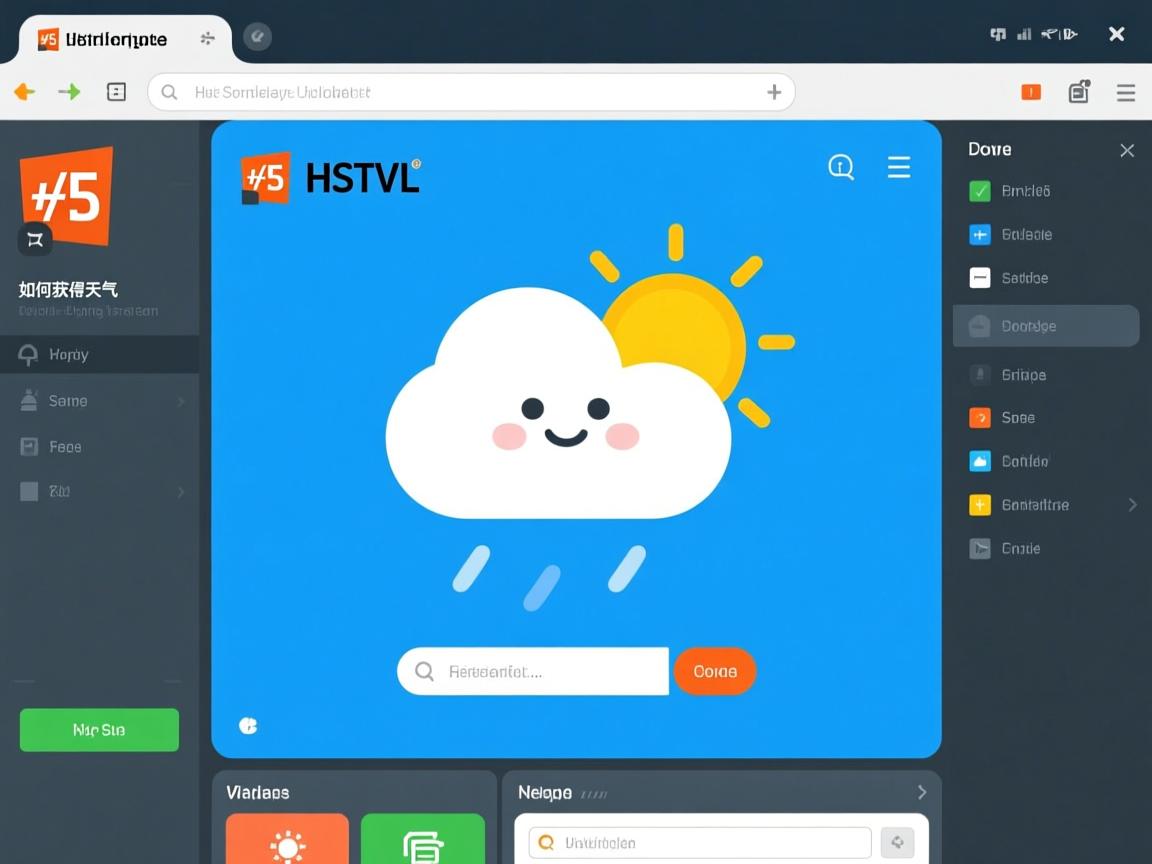html5中如何获取天气
- 前端开发
- 2025-08-05
- 44
HTML5中获取天气信息的核心流程涉及三个关键步骤:获取用户地理位置→调用天气API→解析并展示数据,以下是详细的技术实现方案及注意事项:
获取用户地理位置(基于Geolocation API)
HTML5内置的navigator.geolocation接口允许浏览器主动询问用户是否共享位置信息,这是后续调用天气服务的前提条件,典型代码结构如下:
if (navigator.geolocation) {
navigator.geolocation.getCurrentPosition(successCallback, errorCallback, options);
} else {
console.log("当前浏览器不支持地理定位功能");
}
- 成功回调函数会接收一个包含坐标的对象
position,其中coords.latitude和coords.longitude分别代表纬度与经度; - 错误处理需覆盖多种场景:用户拒绝授权(
PERMISSION_DENIED)、信号弱导致超时(TIMEOUT)、硬件故障等(UNKNOWN_ERROR); - 可通过设置
enableHighAccuracy: false优化移动设备的电量消耗。
示例实现:
function showPosition(position) {
const lat = position.coords.latitude; // 实际纬度值
const lon = position.coords.longitude; // 实际经度值
// 此处应触发下一步的天气数据请求
}
function handleError(error) {
switch(error.code){
case error.PERMISSION_DENIED:
alert("请允许访问您的位置信息以获取当地天气");
break;
case error.POSITION_UNAVAILABLE:
alert("无法确定您的位置");
break;
// ...其他错误类型处理
}
}
调用天气API进行数据交互
主流服务商如OpenWeatherMap、和风天气等均提供RESTful风格的JSON接口,以OpenWeatherMap为例,完整的请求流程包括:

- 注册开发者账号并创建应用获取API密钥(例如
YOUR_API_KEY); - 构造带参数的URL:将之前获得的经纬度代入模板字符串;
- 使用Fetch API发送HTTP请求并处理异步响应。
完整代码片段:
const apiKey = "YOUR_API_KEY"; // 替换为真实密钥
const url = `https://api.openweathermap.org/data/2.5/weather?lat=${lat}&lon=${lon}&appid=${apiKey}`;
fetch(url)
.then(response => response.json())
.then(data => {
// 在此处理原始数据转换逻辑
const celsiusTemp = Math.round(data.main.temp 273.15); // 开尔文转摄氏度
const weatherDesc = data.weather[0].description;
// ...提取其他所需字段
})
.catch(error => console.error("API请求失败:", error));
️注意:部分平台默认返回的温度单位是开尔文尺度,需要进行数学换算才能得到日常使用的摄氏度数值,不同服务商的数据结构存在差异,建议先打印完整响应对象辅助调试。
动态渲染页面元素
将解析后的气象指标注入DOM时,推荐采用模板字符串与innerHTML组合的方式实现批量更新,例如创建一个可视化看板:

<div class="dashboard">
<h2 id="locationName"></h2> <!-显示城市名称 -->
<p>️ <span id="tempValue">--</span>℃</p> <!-实时温度 -->
<p>️ <span id="conditionText">未知</span></p> <!-天气状况描述 -->
<p> 湿度: <span id="humidityPercent">---</span>%</p>
</div>
对应的JavaScript更新逻辑:
function updateUI(weatherData) {
document.getElementById('locationName').textContent = weatherData.name;
document.getElementById('tempValue').textContent = weatherData.main.temp;
document.getElementById('conditionText').textContent = weatherData.weather[0].main;
document.getElementById('humidityPercent').textContent = weatherData.main.humidity;
}
对于更复杂的布局,可以使用表格组织多维度数据:
| 指标 | 数值 | 单位 |
|————-|————|———|
| 体感温度 | 28.5 | °C |
| 降水概率 | 15 | % |
| 风速 | 12.3 | km/h |
增强用户体验的策略
- 加载状态提示:在发起网络请求期间显示旋转动画或“加载中…”文字;
- 缓存机制:利用
localStorage存储最近一次成功获取的数据,减少重复请求; - 自动刷新:通过
setInterval()定时器实现每30分钟自动更新数据; - 错误边界控制:当API不可用时降级显示缓存的历史记录;
- 响应式设计:确保在不同屏幕尺寸下正常显示天气图标和文字。
完整实现示例
以下是整合上述所有功能的最小可行示例:

<!DOCTYPE html>
<html lang="zh-CN">
<head>
<meta charset="UTF-8">HTML5实时天气查询</title>
<style>
.container { max-width: 600px; margin: auto; padding: 20px; border: 1px solid #ccc; }
button { background: #4CAF50; color: white; padding: 10px 20px; border: none; border-radius: 4px; cursor: pointer; }
#weatherInfo { margin-top: 20px; }
</style>
</head>
<body>
<div class="container">
<button onclick="loadWeather()">获取当前位置天气</button>
<div id="weatherInfo"></div>
</div>
<script>
function loadWeather() {
if (!navigator.geolocation) return alert("您的浏览器不支持定位功能");
navigator.geolocation.getCurrentPosition(pos => {
const {latitude, longitude} = pos.coords;
fetch(`https://api.openweathermap.org/data/2.5/weather?lat=${latitude}&lon=${longitude}&appid=YOUR_API_KEY`)
.then(res => res.json())
.then(data => {
const html = `
<h3>${data.name}的天气情况</h3>
<ul>
<li>温度: ${Math.round(data.main.temp 273.15)}℃</li>
<li>天气现象: ${data.weather[0].main}</li>
<li>相对湿度: ${data.main.humidity}%</li>
<li>风速: ${data.wind.speed}米/秒</li>
</ul>
`;
document.getElementById('weatherInfo').innerHTML = html;
});
}, err => alert("定位失败,请检查GPS开关状态"), {timeout: 5000});
}
</script>
</body>
</html>
FAQs:
Q1:如果用户禁止了位置权限怎么办?
A:可以改用城市名称作为备选方案,例如在页面添加输入框让用户手动选择城市,然后构造类似http://api.openweathermap.org/data/2.5/weather?q=Beijing&appid=YOUR_API_KEY的URL进行请求。
Q2:为什么获取的温度值特别低?
A:因为多数API默认返回的是开尔文温度计的值,需要减去273.15才能转换为摄氏度,如果是华氏度需求,则应使用公式(kelvin 273.15) 9/5 + 32进行转换













